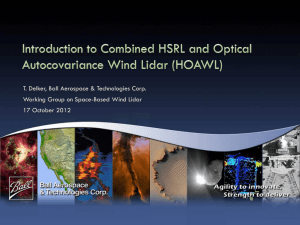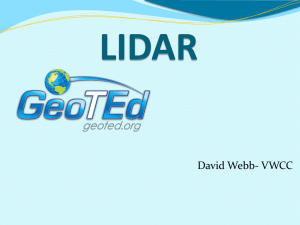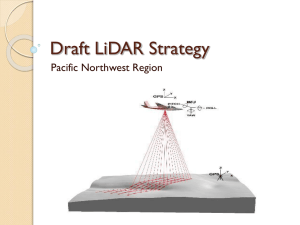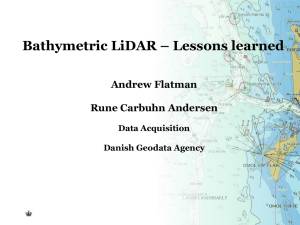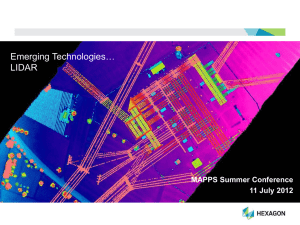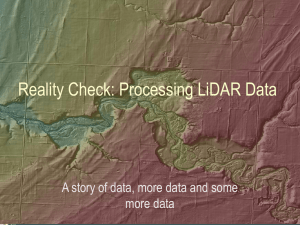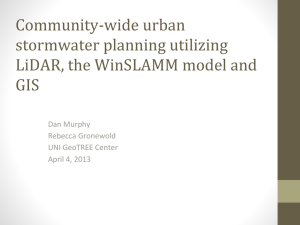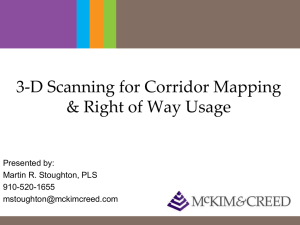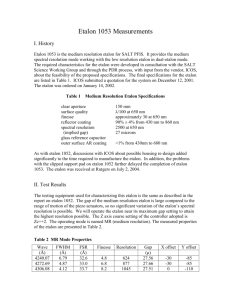FIDDL: Space-Based Wind Lidar Presentation
advertisement
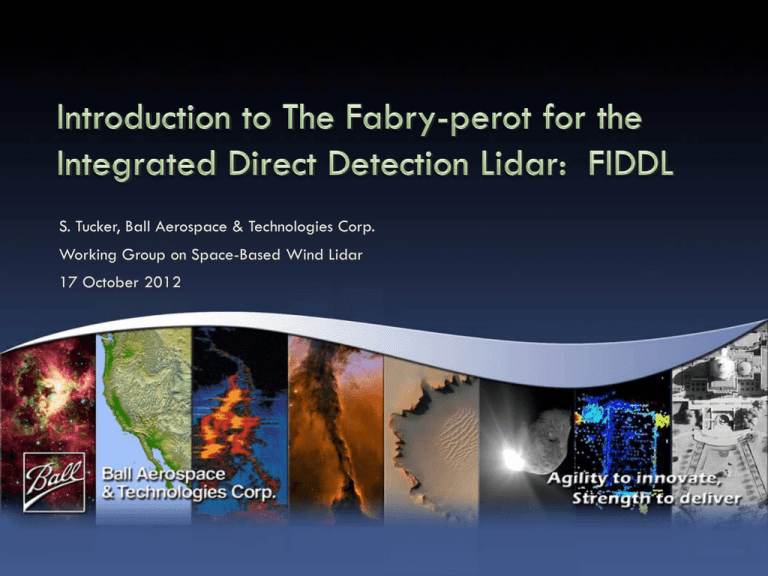
S. Tucker, Ball Aerospace & Technologies Corp. Working Group on Space-Based Wind Lidar 17 October 2012 Introduction: FIDDL & OAWL The Fabry-perot for the Integrated Direct Detection Lidar (FIDDL) is funded under the NASA ESTO Advanced Component Technologies (ACT) program FIDDL fits in the MIDDL: between the OAWL (Optical Autocovariance Wind Lidar) telescope and the OAWL receiver interferometer FIDDL is designed to provide wind estimates from molecular return at 355 nm, and then reflect the aerosol portion of the spectrum (center) on to OAWL FIDDL ACT OAWL IIP One system, one laser, global winds & aerosols. Working Group on Space-Based Wind Lidar, 16-18 October 2012 - Boulder, CO pg 2 The FIDDL team (more to come…) Electrical…………………….... Mike Adkins Co-I, Optical…………………. Tom Delker Optical……………………….. Bob Pierce Models & Control Systems…… Mike Lieber PI, PM, Modeling/Algorithms… Sara Tucker Management Support…………Carl Weimer Ray Demara Working Group on Space-Based Wind Lidar, 16-18 October 2012 - Boulder, CO pg 3 FIDDL Primer: bandwidth of atmospheric lidar return Aerosol return has approximately the same narrow bandwidth as the outgoing laser pulse. Molecular return has a wide bandwidth due to all the Doppler shifts from the molecular vibrations (Doppler broadening). The center of both returns is Doppler shifted by the line-of-sight wind speed V, according to: 2.5 Where fo is the outgoing laser pulse frequency = c/λ0 c is the speed of light Doppler Shift Due to wind 2 Backscatter (W) f Doppler V 2 f0 c 1.5 1 Return spectrum from a Monochromatic source A+M+BG A 0.5 0 M BG 160 80 40 20 10 0 10 20 40 80 160 Wavelength Shift (m/s) Working Group on Space-Based Wind Lidar, 16-18 October 2012 - Boulder, CO pg 4 FIDDL Requirements Overall Science Goals: Pushing for <1 m/s precision in the wind estimate (ground tests) <1 m/s accuracy in the wind estimate For low aerosol loading conditions. 1-2 second time span (TBR based on laser PRF, SNR, etc.) Will aim to verify with OAWL in the overlap (low aerosol) Eventual “synergy” with HOAWL (separate signal processing task) may be used to lessen the impact of aerosol signals through knowledge of the Ra/m Design approach - without risking the technology demonstration Best effort to build the system for aircraft Best effort to make use of components with path-to-space Best effort to design the physical system to fit with current AND future OAWL systems. Working Group on Space-Based Wind Lidar, 16-18 October 2012 - Boulder, CO pg 5 FIDDL Tasks FIDDL is a new receiver component to be added to OAWL. Thus the build requires: Etalon optical design & build Etalon gap control design & build (biggest part!) Input/output optics – to receive light from the telescope, and pass reflected light off to OAWL – design and build. Polarization multiplexing and detector installation Data analysis algorithms and calibration techniques As a lidar, most components already exist as part of OAWL Telescope Laser Data acquisition system Detector design Working Group on Space-Based Wind Lidar, 16-18 October 2012 - Boulder, CO pg 6 FIDDL Block Diagram Edge 1 detector assembly Detection Electronics Edge 2 detector assembly FIDDL optical bench PBS Upstream optics incident reflected PBS QWP Data acquisition (shared with OAWL) Polarization Multiplexing etalon Etalon Control Electronics Working Group on Space-Based Wind Lidar, 16-18 October 2012 - Boulder, CO Downstream optics QWP Plant: Etalon piston/tip/tilt Observers: Capacitive sensing & detectors Actuators: PZTs (3x) From telescope To OAWL Thermal control and pressure monitoring pg 7 FIDDL: Fabry-Perot Basics mλ = 2d cosθ For real lidar systems, we have: lots of frequnencies (input with finite frequency bandwidth > 40 Mhz) Lots of incident angles (θ) due to the receiver field of view & system geometry For FIDDL, both of the above are from the same laser and telescope receiver used for OAWL. 2.5 Doppler Shift Due to wind Backscatter (W) 2 1.5 1 Return spectrum from a Monochromatic source A+M+BG A 0.5 Control over the gap spacing d is one of the main objectives for FIDDL. But we’ll use θ too… M BG 0 160 80 40 20 10 0 10 20 40 80 160 Wavelength Shift (m/s) Working Group on Space-Based Wind Lidar, 16-18 October 2012 - Boulder, CO pg 8 FIDDL Primer: General Double Edge Technique Split the atmospheric return light and send the return light through two Fabry-Perot etalons – symmetrically centered on the edges of an ideal unshifted molecular return. Transmission curves shown as Red and Blue dashed-line curves at right. Dashed green line shows Doppler shifted atmospheric return. The light through each filter (solid lines) is incident on a separate detector. When the center frequency of the return light is Doppler shifted by wind, the relative intensities on the two detectors changes. Molecular+Aerosol return and 2 edge transmissions 1 0.9 0.8 0.7 Transmission 0.6 0.5 0.4 0.3 0.2 0.1 The intensity changes map to the wind speed. Working Group on Space-Based Wind Lidar, 16-18 October 2012 - Boulder, CO -6 -4 -2 0 2 4 Offset center frequency (GHz) 6 pg 9 FIDDL Primer: Fabry-Perot 1st pass NOTE: The plots in this and following slides are outputs from the updated FIDDL Etalon Model Molecular Return and 2 edge transmissions Designed the FP to pass-through a portion of the Doppler broadened molecular return. OAWL receiver passes ~2.4 mrad (full) of field on to the FP – this field effectively broadens the transmission spectrum Green line shows the molecular return spectrum Dashed red shows the etalon transfer function Solid red shows the light transmitted through the etalon. 0.9 0.8 0.7 Transmission 1 0.6 0.5 0.4 0.3 0.2 0.1 -6 Working Group on Space-Based Wind Lidar, 16-18 October 2012 - Boulder, CO -4 -2 0 2 Offset center frequency (GHz) 4 6 pg 10 FIDDL Primer: Fabry-Perot 2nd pass The rejected light (that doesn’t pass through) is transformed (via a QWP and reflection) to the opposite polarization For the 2nd pass through, add a tilt to shift the center of the FOV. Still have a 1.2 mrad total FOV incident on the FP, but it starts off axis. Green line again shows the molecular return spectrum Dashed blue shows the etalon transfer function at the new angle Solid blue shows the light transmitted through the etalon after both passes (note the notch where edge 1 was). Molecular Return and 2 edge transmissions 1 0.9 0.8 0.7 Transmission 0.6 0.5 0.4 0.3 0.2 0.1 Working Group on Space-Based Wind Lidar, 16-18 October 2012 - Boulder, CO -6 -4 -2 0 2 Offset center frequency (GHz) 4 6 pg 11 Unique characteristics of the FIDDL approach… Molecular Return and 2 edge transmissions Transmission through both edges: solid green line shows the center portion which is reflected and passed to OAWL. 1 0.9 0.8 Transmission 0.7 0.6 The same beam passes through BOTH filters (T1 & T2) sequentially. No splitting into two channels so 2X the power can get through on each channel without using polarization recycling. Etalon diameter can be smaller (~1”) reducing risk of thermal effects. 0.5 0.4 0.3 0.2 0.1 -6 -4 -2 0 2 Offset center frequency (GHz) 4 6 Working Group on Space-Based Wind Lidar, 16-18 October 2012 - Boulder, CO Transmission functions are tuned to balance sensitivity to change in frequency and total throughput. Wind speed is related to the ratio of the intensity on detectors (i.e. the total light passed through the separate edge filters). The center frequencies are reflected toward OAWL for aerosol return wind measurement. pg 12 FIDDL Requirements: Etalon Gap Control Etalon Gap Control Three gap observers & three actuators (PZTs) for tip, tilt, and piston (TTP) control of the etalon plate spacing. Gap is measured via measuring capacitance with a capacitance to digital conversion (CDC). Gap shift/error dx relates to a wind speed error dV by c dV dx FSRdx 2d etalon area We are aiming to measure the three gaps with ~16 pm precision or 0.025% of the ~12 GHz FSR* This translates into ~96dB of dynamic range (about 16 bit precision) measurement requirement on the CDC. New Ball Aerospace CDC approach has been demonstrated with test board showing >96 dB of dynamic range. *All listed values TBR Working Group on Space-Based Wind Lidar, 16-18 October 2012 - Boulder, CO pg 13 FIDDL Modeling & Analysis Upgraded and added-to the Ball etalon model(s) Matlab etalon model (originally built on Ball funds) updated and geared to model FIDDL Paired with the OAWL radiometric model (RMM) which All input angles in the FIDDL approach are represented (one dimensional tilt tuning plus two-dimensional input field of view) Developed preliminary wind retrieval algorithms for the unique FIDDL system includes laser transmitter, atmosphere, telescope, photo-detectors, etc. allows for SNR modeling at different altitudes, with varying aerosol/molecular scattering ratios and molecular bandwidths. may be easily updated to integrate new atmospheres Modeled output sensitivity to wind speeds revealing the optimal placement for the lower-finesse filter transmission. Using the models (with the CDC test results) to finalize etalon specifications (trades/balancing of requirements). Working Group on Space-Based Wind Lidar, 16-18 October 2012 - Boulder, CO pg 14 Model Results: optimum edge filter placement New: asymmetric Etalon FIDDL Models Sensitivity (%) /m/s 2.5 2 1.5 1 0.5 1 2 3 4 5 Edge 1 Center, (in HWHH units) Want to maximize the sensitivity to wind speed changes in the molecular channel, with minimal impact on the aerosol channel (passing through to OAWL) Tilt-tuning means that the optimum (most sensitive) Edge 2 and Edge 1 filter centers are asymmetric about 0. Compare results to Flesia and Korb (1999) paper describing optimal placement of symmetric etalons (for 30.1 km alt.) From Flesia & Korb, 1999 Working Group on Space-Based Wind Lidar, 16-18 October 2012 - Boulder, CO Both models peak at ~4X the half width half height at 0.8%. The large difference in the aerosol curve is due to the double pass approach for FIDDL. Flesia & Korb suggest cross-over approach to balance aerosol & molecular… But OAWL provides lidar ratio so we can optimize to reduce impact on the aerosol channel. pg 15 In conclusion… The FIDDL ACT is underway with system models with field and angle tuning radiometric models to understand SNR new CDC designs for etalon gap sensing and control Next major step: specifying the etalon and finding allowed vendor. Expect to have a FIDDL PDR in November Plan to start electronics and optical hardware builds early Spring 2013. Working Group on Space-Based Wind Lidar, 16-18 October 2012 - Boulder, CO pg 16
